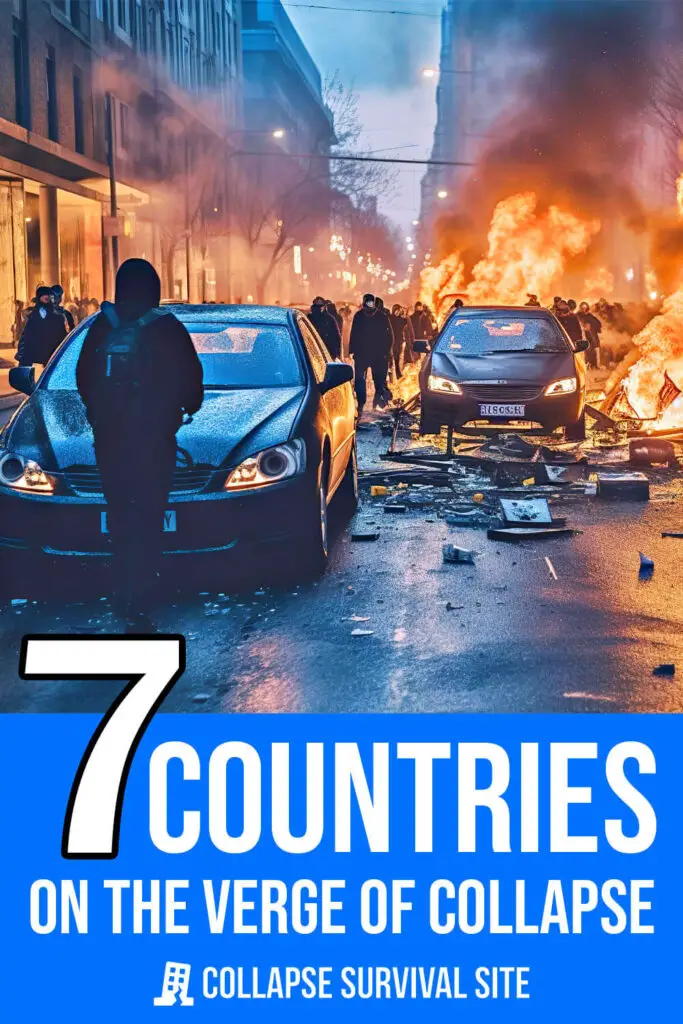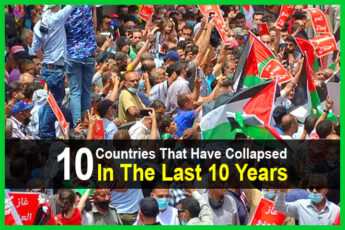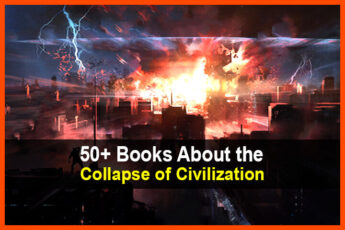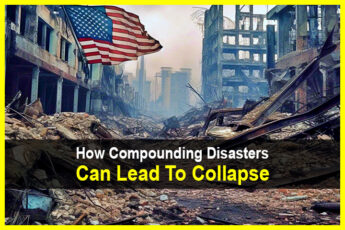Estimated reading time: 9 minutes
Any student of history is keenly aware of the fact that societies and civilizations inevitably fail. Rarely does a single event lead to collapse, but rather a series of events and conditions that make a country it’s society and institutions a fragile house of cards.
The events and patterns of the past have been clearly identified and it’s only in hindsight that the inevitable failure of a society, and the borders that define it as a country diminish, fail and fall. What’s troubling is that those patterns and events are emerging again today in countries around the world. More to the point is that we’re seeing some of those patterns in the United States but we’ll get to that later.
Want to save this post for later? Click Here to Pin It On Pinterest!
Key Collapse Factors
When you look at the factors that bring a country and society to the edge of collapse the primary event that often destroys the fundamental institutions and structures is war. Civil war is the predominant conflict but interstate wars often leave the greatest destruction.
Another event that often leads to the collapse of a society is a catastrophic natural disaster. Earthquakes in Syria and hurricanes in Haiti devastated the countries, and the instability of their regimes and continuing civil unrest added to the chaos.
The failure of the economy in these countries causes a breakdown in institutions and the availability of general goods and services including food, water and healthcare. In some instances economic failure is the first event that brings a country to its tipping point, as other events and incidents compound the challenges leading to collapse.
From Compound to Cascading Collapse
A compound disaster is the occurrence of two or more significant events that are unrelated but occur at the same time. A classic example was during the COVID pandemic when countries were reeling from the impacts on their economies and health care systems, and then further challenged by everything from wildfires to typhoons, to earthquakes, tsunamis and the ever present civil unrest.
These disasters can also cascade as climate change brings drought to a region followed by wildfires, flash flooding, power outages and on and on. It sounds like a scenario from a disaster movie but it’s happened and is happening now. Here are some of the countries headed for collapse and the factors that have aggravated and fueled the disaster.
1. Afghanistan
Afghanistan has endured decades of conflict fueled by civil war, extreme religious fundamentalism and a failing economy with few developed resources. The withdrawal of foreign troops and chaotic leadership across rival factions have increased the chaos and wars have left most cities in a shambles with little or no infrastructure to support the population.
Since 2021, the Afghan economy has lost $5 billion destroying any wealth it managed to accumulate. Things have gotten so bad that the International Monetary Fund has excluded Afghanistan from any future monetary projections. In the meantime, basic human services including food assistance, sanitation, energy, shelter, education and healthcare have ceased to function in a society in a spiral to complete collapse.
2. Russia
Russia’s institutions are inherently weak. The rule of law is arbitrary and often imposed for political purposes while there continues to be little or no protection of basic property rights. Corruption is widespread and the ongoing war in Ukraine has resulted in broad and sweeping sanctions that continue to cripple its economy. Another lesson from history is that efforts to recapture territories once considered part and parcels of an empire are doomed to fail.
The result has been high inflation, deep recession, shortages which have always been ever-present in Russia in addition to an escalation of rising prices. Russia’s GDP holds the lowest ranking across global averages and corruption across the government and industries continues to cripple its ability to fully function. As the war in Ukraine continues so will the decline and eventual collapse of Russia.
3. Venezuela
Much of the migrant crisis at the Southern border of the U.S. has been fueled by a massive migration of Venezuelans. In a little more than a decade Venezuela went from one of the fastest rising economies in Latin America to an economy in ruins. An ironic twist in a petrostate with the world’s largest reserves of crude oil.
It was the dependence on oil as the primary economic driver that created a mono-economy solely dependent on oil exports to drive its GDP. The influx of cash from oil led to a socialist government that freely dumped cash into social programs.
It was in 2014 that the collapse of their oil economy began leading to an economic collapse not seen since the Great Depression of 1929. The regime was incapable of managing events and basic needs like food, water, sanitation, health care and even things as basic as soap were unavailable. Complicating everything was a pattern of corruption in government and corporations.
The result was widespread civil unrest and protests filled the streets of cities across the country. Nicola Maduro emerged as President in a hotly contested election and instituted draconian measures to quell the protests. Violating both the constitution of the country and the will of its people, Maduro essentially instituted martial law as people continue to flee the country as it descends further into collapse and an emerging civil war.
4. Syria
Since 2011 Syria has been devastated by a civil war that continues to this day. In the meantime, the brutal dictatorship of Bashar Assad has used the army to quell protests resulting in widespread arrests fueling the complexity of the civil war.
The country; its cities and industries are in a shambles as outbreaks of violence continue in streets patrolled by military police looking for the slightest sign of protest or resistance.
Once again, basic human services are simply non-existent as necessities like food, water and healthcare are just not available to the general population. Russia continues to fuel the chaos as the country continues to spiral to complete collapse while millions of Syrians are left homeless.
5. Belarus
Corruption and another brutal dictatorship pervades Belarus while property rights are again denied and the economy continues to fail. The alliance with Russia and the support of Vladimir Putin by Alexander Lukashenko has led to sanctions resulting in a severe shortage of basic necessities and rampant inflation. Its GDP over the last 5 years is reported at 0% and it’s only a matter of time before its growing protests devolve into civil war.
6. Ukraine
Ukraine was once a thriving agricultural economy driven largely by its wheat crops. The war with Russia has destroyed many of its cities, stopped its ability to export wheat and grains and maintain basic institutions and services.
It’s estimated that reconstruction costs across the country will total $349 billion. Its GDP has declined by 35% and there’s no end in sight for the continuing conflict. If or how well the country and its society survives remains to be seen.
7. United States?
It’s hard to imagine how the world’s largest and most robust economy built on a foundation of democracy and the rule of law could fail, but there are some ominous signs. Violent protests have occurred recently from the Portland riots to January 6th, and the political polarization continues.
What’s particularly troubling is the unimaginable possibility of Civil War. There are some startling patterns that emerged in the1850’s that served as a prelude to the American Civil War that have started to show up will troubling regularity.
Worse, two of the primary indicators of societal collapse measured over 10,000 years of civilizations indicate that economic disparity or “immiseration,” and an employment situation where even the most educated can’t find positions of employment consistent with their ability and education.
They’re factors not usually mentioned in the usual lists of civil unrest, natural disasters and economic collapse that are often assumed to be the primary cause of a societal failure.
Going back to the pre-Civil War analogy of the 1850’s, some specific events precipitated that conflict:
- A period of employment challenges emerged in the 1850’s where highly educated people had to fiercely compete for jobs or positions in industry or politics. Competition has always been touted as a positive but when there end up being only a few winners and masses of resentful losers –competition fails.
- Economic disparity grew from 1800 to 1850 ask the rich not only became richer but everyday wages declined by nearly 50%. As the upper-upper class prospered everyday Americans suffered with both a decrease in life expectancy up to 8 years, and a nutritional marker indicated by a 2-inch decrease in the average height of Americans during that time.
- From 1855 to 1860 urban riots devastated 38 cities across the U.S. Most of the riots were against immigration fueled by an off-shoot of the Republican party known as the “Know-Nothing-Party.” It was originally called the American Party but the Know Nothings based their platform on the concept of a great conspiracy behind immigration with their principles driven by secrecy, patriotism and Protestantism.
- The wealthy elites, particularly Southern slaveholders began to dominate politics. Violence was sometimes the result as Preston Brooks of South Carolina beat Senator Charles Sumner of Massachusetts with a can in 1856.
- In 1850, Senator Henry Foot of Mississippi brought a pistol to the Capitol and pointed it at Senator Thomas Hart Benton of Missouri. This intra-elite violence paralleled the popular violence and protests still occurring.
If you can think of any analogies to today’s political and civil environment you can see how threats emerge and grow. But of course there’s more to the patterns and events.
- The American economy which seems so resilient and resistant to downturns continues to struggle. And it’s not about the stock market. Ever since the Black Friday crash of 1929 precipitating the Great Depression, we’ve continued to see the stock market as the canary in the coal mine for economic measures. Other measures may be more ominous.
- Inflation continues and prices continue to rise in an environment where everyday people have exhausted their savings and are forced to compromise on many things they buy. Worse, recent litigation has found that some companies have artificially hiked prices through price fixing. As the everyman struggles the large corporations and wealthy elite continue to prosper.
- Once again, everyday wages are running 50% lower than they were 50 year ago. Another ominous parallel to the statistics in the 1850’s before the Civil War.
And the Usual Suspects Still Rule
Natural disasters, the uncertain chaos of climate change, deepening political polarization, corruption, the list goes on. Many ancient civilizations collapsed due to any one or more of those conditions. And surrounding it all was poor leadership, dictatorship, corruption and the inevitable wars civil and otherwise.
The U.S. has survived its share of challenges from World Wars to the economic recessions and depressions. What’s chilling is that so many patterns are emerging that reflect the disasters of the past. The only question is whether or not we can avoid that perfect storm of events that have spelled the inevitable collapse of many societies and countries in the past.







